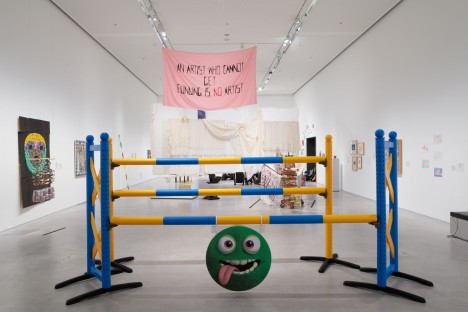Review
Class Issues: Art Production In and Out of Precarity
Martin Herbert encounters an all-too-rare exhibition exploring the issue of classism

‘Class Issues: Art Production In and Out of Precarity’, Berlinische Galerie, Berlin
Passing by the Berlinische Galerie’s bookshop on my way into ‘Class Issues’, I asked if there was a catalogue for the show. No, the attendant said, it’s too small an exhibition for that. This 39-artist consideration of the impact of class on art-making was, indeed, squeezed into a fraction of the space that the institution was concurrently giving to a big, drab survey of Hungarian modernist painting. Yet it is to the credit of the venue and its co-organisers here, the politically minded Gesellschaft für bildende Kunst or nGbK (lately forced out of a central-Berlin gallery space by rising rents), that the show happened at all, given the near-silence on classism and its discontents throughout contemporary art discourse.
If you have taught in art schools over the past decade, or even just developed some awareness of the social demographics of emerging artists nowadays, you know that class is a deeply troubling issue, if not a timebomb. Compared with, say, the mid 1990s, it is a different world today: art education fees are expensive, which increasingly excludes working-class practitioners, leading in turn to an intake of cushioned and often careerist individuals who rarely think about or articulate class concerns because they don’t have to and, anyway, they are too busy second-guessing the art market; and thus, circularly, you have a gallery circuit in which class rarely comes up as an issue, so it never becomes a ‘hot’ subject. The muting of those without a financial parachute continues outside of art school – this also being the case in mainland Europe where art education itself might be free – since studios and cities where one might once have worked and networked have themselves become prohibitively expensive, and time taken by necessary employment cuts into art-making time. Those who somehow continue undaunted amid all this often do so under conditions of, as the show’s title suggested, continuing precarity, a latter-day buzzword that still often feels unmoored from class issues or at least from the concept of collective action, as though precariousness is somehow every self-employed person’s private burden. Very little of this is openly discussed or highlighted, particularly in comparison with the airtime given to identity issues (as, indeed, Mark Fisher pointed out in his divisive 2013 essay ‘Exiting the Vampire Castle’), such that shared class-struggle concerns never, through conspiracy or otherwise, unify those who would benefit most.
‘Class Issues’ was, perhaps appropriately, a ramshackle-looking if plucky response to all of this, the combined cost of its materials probably less than that of the typical medium-sized gallery dinner. It mingled a handful of historical works from the Berlinische Galerie’s collection with others by contemporary artists, such that the show opened with works by Hannah Höch, who despite being from a middle-class Berlin background gravitated to ‘poor’ materials such as collage. The plangent text-based gouache I am a Poor Animal, 1959, made when Höch was 70, reflects the fact that she was on financial assistance when she made it. Suspended from the ceiling nearby, meanwhile, was Vlad Brateanu’s hand-painted banner An Artist Who Cannot Get Funding is No Artist, 2021 (a response, in turn, to Mladen Stilinovic’s 1994 work An Artist Who Cannot Speak English is No Artist), whose wall label noted that the Berlin-based Romanian artist made 17 funding applications in 2021, none of them successful. That’s one, frequently invisible, end of our current art world; at the other, Hito Steyerl, who famously theorised the ‘poor image’, here collaborated with Giorgi Gago Gagoshidze and Milos Trakilovic to present BELANCIEGE Mug, 2019, an editioned ceramic cup sardonically priced at an extortionate $11,000, blazoned with a knock-off logo resembling that of Balenciaga, which does nicely out of repurposing ‘poor’ aesthetics as high fashion and which has cred aplenty among the herd-like art cognoscenti.
Steyerl and co’s response is darkly funny, and laugh-or-cry humour leavens other contributions too. Mika Svolos’s ink drawing Prolific Artist, 2022, which was sent through the mail from the artist’s base in Athens, is a little cartoon of a beret-wearing figure who has painted a small dot on the wall, subtitled ‘Artist has enough paint to only make a point’. But that’s cheek-by-jowl with Martin Elmar de Haan and Anonymous’s Projekt Diogenes, 2022, referencing the philosopher who voluntarily lived in a barrel and comprising a supermarket trolley overflowing with paintings, scraps of fabric and sculptural arrangements of found wood, and made by a homeless collective that has lately mounted public artworks and makeshift concerts in the local area (until the police close them down), and whose members currently, it seems, live on a strip of grass not too far from the gallery where many Kreuzberg-based art-world denizens have probably strolled right past them on the way to a white-cube gallery. Elsewhere, precarity and exclusion were continually reframed in the service of potential cross-constituency solidarity, visualising a precariat coalition in space rather than nodding to the vague idea of one; the artist and architect Paul Goesch – maker, here, of four small gouaches from 1919–21, including one of two anthropomorphic cigarette butts frolicking in an ashtray – was excluded from Berlin’s avant-garde scene in the 1920s through mental illness. Verena Pfisterer’s delicate drawings, including plans for public sculptures and mechanised objects, mostly reflect projects that never got off the drawing board since the artist (who came from a fairly penurious single-parent background, actively withdrew from the art world in the early 1970s and died, in her early 70s, in 2013) was too busy doing ‘proper’ jobs. Several other artists, in the thumbnail biographies on their wall texts, attest to problems in art education stemming from not knowing or understanding the vocabulary – or, rather, mandarin jargon – of contemporary art in their second language after moving to a different country due to regime changes in their own.
As a viewing experience, ‘Class Issues’ was herky-jerky, motley and provisional, sometimes more akin to a demo directly outside an art museum than an exhibition inside one; but that made sense, too, since the show was intended as a convening of disparate parties who have an underlying cause in common. It opened not with anything welcoming but with an obstructing metal barrier, the sort you see in showjumping: a ‘curatorial intervention’ painted, for unspecified but perhaps not coincidental reasons, in the colour of the Ukrainian flag and accessorised with an oversized cut-out emoticon of a nausea-green googly-eyed face. It closed, if you viewed the show clockwise, with a provoking voluntary survey asking pointed questions about the viewer’s own economic footing and what, if anything, might improve it. Such moves suggested a desire to open an honest, bubble-bursting conversation rather than to stake out, and own, a given space of discourse within exhibition-making. Generally, when an institutional group show appears with a given and legible theme, other curators tend to shy away from copying it, considering the subject closed. ‘Class Issues’ ought to be an exception.
‘Class Issues: Art Production In and Out of Precarity’, Berlinische Galerie, Berlin, 25 November 2022 to 9 January 2023.
Martin Herbert is a writer and critic based in Berlin.
First published in Art Monthly 463: February 2023.









